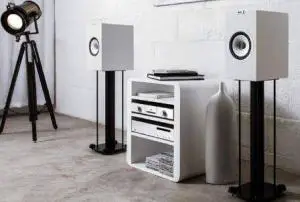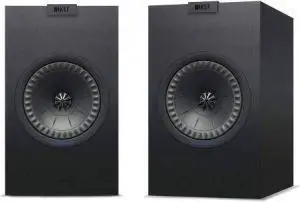Table of Contents
A living room without a quality speaker set can often seem a little naked. Considering the multiple uses of speaker sets, it’s worth investing in one to enhance your music, movies, and gaming experience. But with so many to choose from, it’s not easy getting the right combination of design and sound quality.
We are going to take a look at the KEF Q100 vs Q150. We will compare their appearance, optimal uses, sound quality and value for money. You will be able to find a comparison chart and some pros and cons to decide which of the two speaker sets is the best buying option.
We will start by looking at what the KEF Q100 and the KEF Q150 have in common.
KEF Q100 vs Q150 – Similarities
Quick Glance
Now that we have covered all of the KEF Q100 and the KEF Q150 specifications, we can have a look at each of the features side by side in the following comparison chart.




Speaker Types
The KEF Q100 and the KEF Q150 are both bookshelf speakers. They are designed to sit on shelves or on speaker stands with a distance from the wall of 9 inches so that the rest port at the back of the speakers can breathe.
Passive Speakers
Because they are passive speakers, you will need an amplifier with the KEF Q100 and the KEF Q150. The required amplifier is 10-100W.
Sensitivity
The sensitivity of a speaker is the level of sound pressure right in front of the speaker. Good sensitivity ratings can be anywhere from 84dB to 90dB. The KEF Q100 and the KEF Q150 have a sensitivity rating of 87dB.

Dome Tweeters
The dome tweeter in a speaker is what helps to deliver the higher frequencies. The KEF Q100 and the KEF Q150, like most speakers, have one-inch domes. The domes are made of aluminum, which makes the high sounds crisp and loud.
Maximum Output
Though the maximum output of the KEP Q100 is 107dB and the KEF Q150 is 108dB, most consider this an imperceptible difference. This would be almost like listening to a rock concert from the first row, a jackhammer, or a symphony orchestra— so loud!
5.25-inch Uni-Q Driver Array
The KEF Q100 and the KEF Q150 come with the latest innovative KEF design which places the tweeter in the acoustic center of the midrange cone. This allows for more detail in the sound and a more accurate ·D sound image is spread across the room. When combined with the KEF’s tangerine waveguide over the dome spreads the sound further and more evenly.
Now that we have covered the similarities between the KEF Q100 and the KEF Q150, we will turn our attention to how they are different.
Differences Between KEF Q100 and KEF Q150
Appearance

Both the speaker sets are super modern looking, especially in white. There are however a few design differences.
KEF Q100
Each speaker is 11.8 x 7.1 x 10.7 inches. They weigh 13 pounds, 26 pounds combined. You have the choice of white, American walnut, and rosewood.
KEF Q150
There isn’t a great deal of difference in the size at 11.92 x 7.08 x 10.9 inches. One speaker weighs 12.3 pounds and together they weigh 24.6 pounds. This set comes in either black or white.
The Winner Is- A Tie
Read next – Yamaha Hs7 vs HS8: Which Studio Monitor is Better?
Frequency Response

In general, humans hear from 20Hz to 20kHz, this is the absolute lowest bass sounds we can hear to the highest treble notes respectively.
KEF Q100
These speakers have a frequency range of 49Hz to 40,000Hz.
KEF Q150
In the case of these speakers, the frequency range is 51Hz to 28,000Hz.
The Winner Is- A Tie
Pros and Cons
Because on paper, the KEF Q100 and the KEF Q150 are so similar, it might be down to the pros and cons of each to decide on the best buy.
KEF Q100

Pros:
- For a bookshelf speaker, they have an incredible bass
- There is no need to hook them up to center speakers or woofers, the amount of sound is outstanding
- Clear and crisp sounds even when the volume is low
Cons:
- You need to make sure you buy them when they are on offer and the build quality is impressive
KEF Q150

Pros:
- They are much better looking with the driver in the center
- The bass frequency goes much lower than the advertised 51Hz
- The even distribution of the sound across the room is amazing
Cons:
- At full price, you might be expecting a little more
The Final Verdict
When it came to the design it was nice to have the additional color option with the KEF Q100, but we preferred the white options for both. The overall look of the KEF Q150 was much nicer having just the drive in the center. It also helped that they were a couple of pounds lighter.
The KEF Q150 is the latest version so you would expect to have some improvements in the sound quality. We did notice a greater range between the base and the high trebles and just a little crisper with voices. That being said, you wouldn’t be disappointed with the sound that the KEF Q100 produces.
The decision ultimately came down to value for money. The product description has no information on the warranty for the KEF Q150, but we did find out that it was the same as the KEF Q100, so five years. The original price for both the KEF Q100 and the KEF Q150 was over $500. Many agree that the KEF Q150 is worth this price but not the KEF Q100. On sale, you can find both for similar prices. For this reason, we decided that the KEF Q150 was the better purchasing choice.
Last update on 2024-04-18 / Affiliate links / Images from Amazon Product Advertising API
